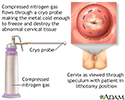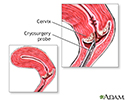Cervix cryosurgery
Cervix surgery; Cryosurgery - female; Cervical dysplasia - cryosurgery
Cervix cryosurgery is a surgical treatment to freeze and destroy abnormal tissue in the cervix .
Cervix
The cervix is the lower end of the womb (uterus). It is at the top of the vagina. It is about 2 inches (5 centimeters) long. The cervical canal pa...

Description
Cryotherapy is done in the health care provider's office while you are awake. You may have slight cramping and flushing in the face, however cryosurgery is mostly painless.
To perform the procedure:
-
An instrument is inserted into the
vagina
to hold the walls open so that the doctor can see the cervix.
Vagina
The vagina is the female body part that connects the womb (uterus) and cervix to the outside of the body.
 ImageRead Article Now Book Mark Article
ImageRead Article Now Book Mark Article - The doctor then inserts a device called a cryoprobe into the vagina. The device is placed firmly on the surface of the cervix, covering the abnormal tissue.
- Compressed nitrogen gas flows through the instrument, making the metal cold enough to freeze and destroy the tissue.
An "ice ball" forms on the cervix, killing the abnormal cells. For the treatment to be most effective:
- The freezing is done for 3 minutes
- The cervix is allowed to thaw for 5 minutes
- Freezing is repeated for another 3 minutes
Why the Procedure is Performed
This procedure may be done to:
-
Treat
cervicitis
Cervicitis
Cervicitis is swelling or inflamed tissue of the end of the uterus (cervix).
 ImageRead Article Now Book Mark Article
ImageRead Article Now Book Mark Article -
Treat
cervical dysplasia
Cervical dysplasia
Cervical dysplasia refers to abnormal changes in the cells on the surface of the cervix. The cervix is the lower part of the uterus (womb) that open...
 ImageRead Article Now Book Mark Article
ImageRead Article Now Book Mark Article
Your provider will help you to decide if cryosurgery is right for your condition.
Risks
Risks for any surgery are:
- Bleeding
- Infection
Cryosurgery may cause scarring of the cervix, but most of the time it is very minor. More severe scarring may make it more difficult to get pregnant, or cause increased cramping with menstrual periods.
After the Procedure
You might feel lightheaded right after the procedure. If this happens, lie down flat on the examination table so that you do not faint. This feeling should go away in a few minutes.
You can resume almost all of your normal activities right after surgery.
For 2 to 3 weeks after the surgery, you will have a lot of watery discharge caused by the shedding (sloughing) of the dead cervical tissue.
You may need to avoid sexual intercourse and using tampons for several weeks.
Avoid douching, because douching can cause severe infections in the uterus and tubes.
Outlook (Prognosis)
Your provider should do a repeat Pap test or biopsy at a follow-up visit to make sure that all abnormal tissue was destroyed.
Pap test
The Pap test checks for cervical cancer. Cells scraped from the opening of the cervix are examined under a microscope. The cervix is the lower part...

Biopsy
A biopsy is the removal of a small piece of tissue for laboratory examination.
You may need more frequent Pap smears for the first 2 years after cryosurgery for cervical dysplasia.
References
American College of Obstetricians and Gynecologists. Practice Bulletin No. 140: management of abnormal cervical cancer screening test results and cervical cancer precursors. Obstet Gynecol . 2013;122(6):1338-1367. PMID: 24264713 www.ncbi.nlm.nih.gov/pubmed/24264713 .
Lewis MR, Pfeninger JL. Cyrotherapy of the cervix. In: Pfenninger JL, Fowlder GC, eds. Pfenninger & Fowler's Procedures for Primary Care . 3rd ed. Philadelphia, PA: Elsevier Mosby; 2011:chap 138.
Noller KL. Intraepithelial neoplasia of the lower genitaltract (cervix, vulva): etiology, screening, diagnostic techniques. In: Lentz GM, Lobo RA, Gershenson DM, Katz VL, eds. Comprehensive Gynecology . 6th ed. Philadelphia, PA: Elsevier Mosby; 2012:chap 28.
-
Female reproductive anatomy - illustration
External structures of the female reproductive anatomy include the labium minora and majora, the vagina and the clitoris. Internal structures include the uterus, ovaries and cervix.
Female reproductive anatomy
illustration
-
Cervical cryosurgery - illustration
Cryosurgery is performed by freezing and destroying abnormal tissue.
Cervical cryosurgery
illustration
-
Cervical cryosurgery - illustration
Cryosurgery is super-freezing of tissue in order to destroy it. This procedure may be done to treat cervicitis or cervical dysplasia.
Cervical cryosurgery
illustration
-
Female reproductive anatomy - illustration
External structures of the female reproductive anatomy include the labium minora and majora, the vagina and the clitoris. Internal structures include the uterus, ovaries and cervix.
Female reproductive anatomy
illustration
-
Cervical cryosurgery - illustration
Cryosurgery is performed by freezing and destroying abnormal tissue.
Cervical cryosurgery
illustration
-
Cervical cryosurgery - illustration
Cryosurgery is super-freezing of tissue in order to destroy it. This procedure may be done to treat cervicitis or cervical dysplasia.
Cervical cryosurgery
illustration
Review Date: 4/5/2016
Reviewed By: Irina Burd, MD, PhD, Associate Professor of Gynecology and Obstetrics at Johns Hopkins University School of Medicine, Baltimore, MD. Review provided by VeriMed Healthcare Network. Also reviewed by David Zieve, MD, MHA, Isla Ogilvie, PhD, and the A.D.A.M. Editorial team.



